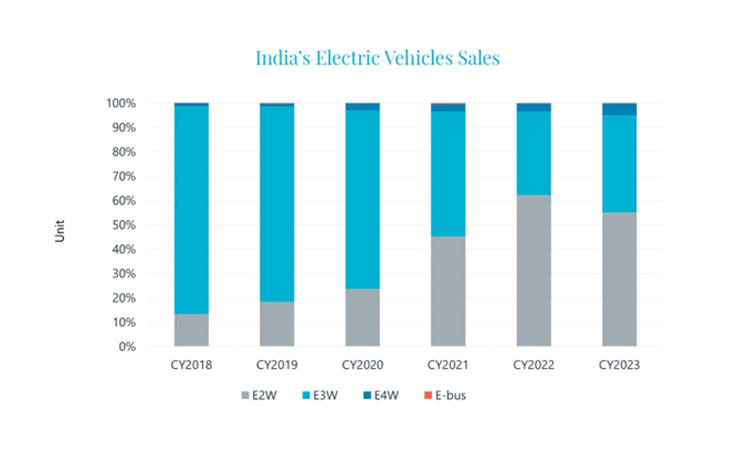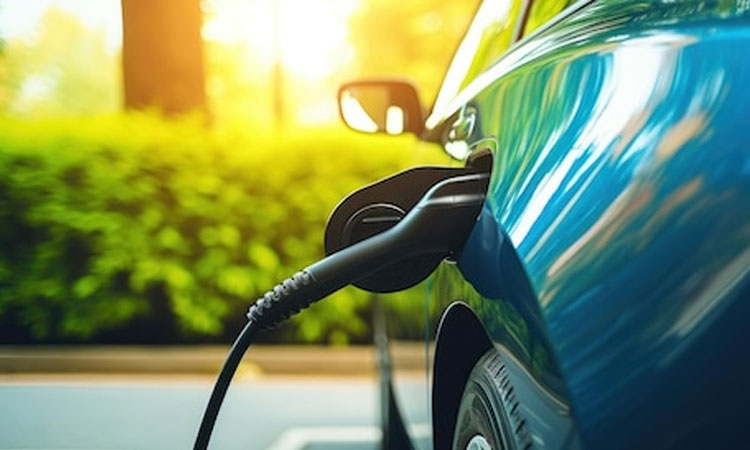The rapid expansion of India’s electric vehicle (EV) and energy storage markets is fueling the development of the domestic battery industry. However, challenges such as insufficient domestic battery cell production capacity and raw material shortages are impeding its growth. To address these hurdles, the Indian government has introduced incentive policies to promote the localization of battery cells, attracting both domestic and foreign investments in battery factories. Despite active responses from domestic companies and keen interest from overseas manufacturers, issues related to domestic industry protection and the business environment remain obstacles, resulting in a relatively slow development of the domestic battery industry chain.
India’s Flourishing Domestic Electric Vehicle Market
India’s NITI Aayog policy think tank set ambitious targets in 2019 to increase the proportion of electric passenger vehicles to 30% and electric commercial vehicles to 70% by 2030. However, despite government support and global demand for new energy vehicles, progress has been slow. High tariffs on imported electric vehicles, intended to encourage localization, have deterred leading manufacturers like Tesla, contributing to the market’s sluggish development. As of 2023, the penetration rate of electric vehicles in India stood at only 6.6%, with electric passenger cars accounting for approximately 1.7% of the market.
The Enormous Potential of the Energy Storage Market
According to a report by the Central Electricity Authority (CEA) of India, the demand for energy storage in India is predicted to reach 60.63 GW/336.4 GWh by 2030. Incentives introduced by the Indian government, such as the Viability Gap Funding (VGF) program, aim to reduce deployment costs for energy storage projects. Additionally, funds have been allocated to support the deployment of approximately 4 GWh of battery energy storage systems. Interact Analysis forecasts that by 2030, India is set to become the world’s third-largest electrochemical energy storage market.

Challenges Facing the Lithium-Ion Battery Market in India
The Indian battery market faces numerous challenges, primarily due to limited raw materials and production capacity. India lacks abundant lithium mining resources and heavily relies on imports. While domestic battery pack production has been expanding, the production capacity for battery cells remains relatively limited. Among the top ten battery companies globally, only Samsung SDI has a cell manufacturing facility in India. As a result, India primarily depends on imports to meet its market demand.
Government Initiatives and Industry Response
To overcome these challenges, the Indian government is actively promoting the localization of battery cell production. The inclusion of the Advanced Chemistry Cell (ACC) project in the Production Linked Incentive (PLI) scheme aims to incentivize battery companies to localize production in India through subsidies. The first round of bidding for the ACC PLI concluded in March 2022, with significant capacity allocations to Indian companies. Subsequent rounds are expected to further drive the development of India’s battery industry, with more domestic and international companies planning to build battery gigafactories in India.
Final Thoughts
Countries worldwide aspire to build domestic supply chains and reduce dependence on imports to advance industrial development. In Southeast Asia, countries like Thailand, Vietnam, and Indonesia have witnessed active expansion in the electric vehicle and battery industries. The Indian government’s recent reduction in import tariffs for electric vehicles and other positive signals create a conducive environment for the domestic battery industry’s growth.
 Article Contribution: Yvonne Zhang – Research Associate at Interact Analysis
Article Contribution: Yvonne Zhang – Research Associate at Interact Analysis
Yvonne joined Interact Analysis as a Research Associate to assist the research team with organizing, interpreting findings, and enhancing product outputs. She has a master’s degree in Finance and has research experience in the Industrial Automation sector after her studies in the United States.



